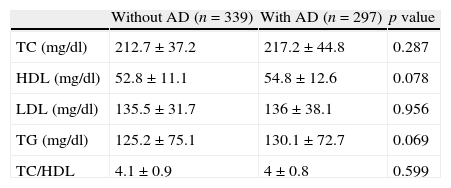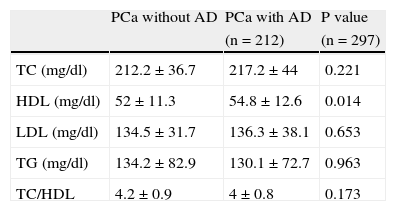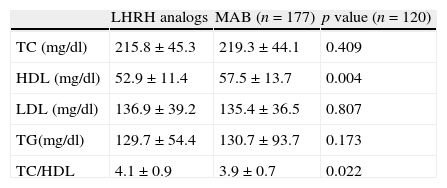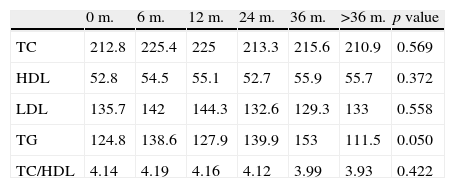This study has aimed to analyze the changes observed in the lipid profile and atherogenic risk in prostate cancer patients subjected to androgen deprivation.
Material and methodsBetween 2001 and 2008, serum lipoproteins (total cholesterol, HDL, LDL and triglycerides) were determined in 636 patients. Of these, 129 were treated with maximum androgen blockade and 177 patients were only treated with LHRH analogue. The control group was formed by 339 subjected to prostate biopsy (212 with prostate cancer and 127 without prostate cancer). The atherogenic risk was calculated using the Castelli formula (total cholesterol/HDL).
ResultsMean atherogenic risk was 4.2 in the control group and 4 in the group of patients subjected to androgenic deprivation, p>0.05. The mean atherogenic risk in those subjected to monotherapy with LHRH analogues was 4.1 while it was 3.9 in patients subjected to maximal androgen blockade, p=0.02. We did not find significant differences for atherogenic risk according to length of treatment, p>0.05. The multivariate analysis confirmed that the treatment modality was the only significant variable influencing atherogenic risk.
ConclusionsThis study demonstrates that continuous androgen deprivation does not increase atherogenic risk in patients with prostate cancer. This risk did not increase during the treatment either. The association of bicalutamide to the LHRH analogue seems to have a protective effect on atherogenic risk.
Analizar los cambios observados en el perfil lipídico y el riesgo aterogénico en pacientes con cáncer de próstata sometidos a supresión androgénica.
Material y métodosLos niveles séricos de lipoproteínas (colesterol total, colesterol HDL, colesterol LDL y triglicéridos) fueron determinados en 636 pacientes entre 2001 y 2008. De estos,120 fueron tratados con bloqueo androgénico máximo y 177 fueron tratados únicamente con análogo de LHRH. El grupo control estaba formado por 339 pacientes sometidos a biopsia prostática (212 con cáncer de próstata y 127 sin cáncer de próstata). El riesgo aterogénico fue calculado según la fórmula de Castelli (colesterol total/HDL).
ResultadosEl riesgo aterogénico medio en el grupo control fue de 4,2 y de 4 en el grupo sometido a supresión androgénica (p>0,05). El riesgo aterogénico medio en los pacientes sometidos a monoterapia con análogos de LHRH fue de 4,1, mientras que en los pacientes en tratamiento con bloqueo androgénico máximo fue de 3,9 (p=0,02). No se observaron diferencias significativas del valor del riesgo aterogénico en función de la duración del tratamiento. El análisis multivariante confirmó que la modalidad de tratamiento fue la única variable significativa respecto al riesgo aterogénico.
ConclusionesEste estudio demuestra que la supresión androgénica no incrementa el riesgo aterogénico en pacientes con cáncer de próstata. Este riesgo tampoco se incrementa a lo largo del tratamiento. La asociación de la bicalutamida al análogo de LHRH parece ejercer un efecto protector sobre el riesgo aterogénico.











